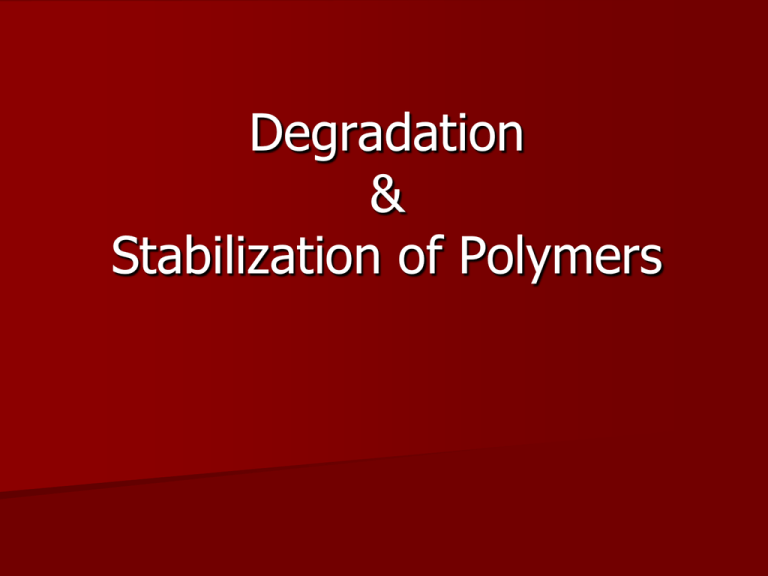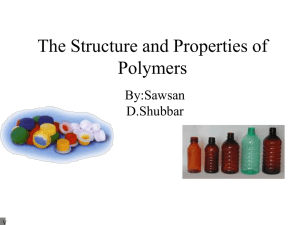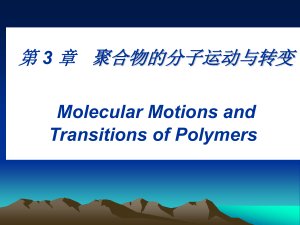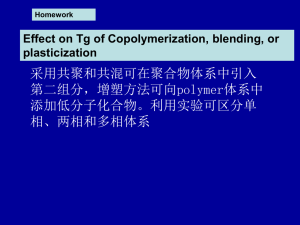Degradation & Stabilization of Polymers
advertisement

Degradation & Stabilization of Polymers Resin Identification Code The Society of the Plastics Industry, Inc. (SPI) introduced its resin identification coding system in 1988 at the urging of recyclers around the country Plastics A Plastic is... .. a material that contains as an essential ingredient, an organic high molecular weight polymer, is solid and rigid in its finished state, and at some stage in its manufacture or its processing into a finished article, can be shaped by flow. Production of polymer-based products Primary Resources Basic Petrochemical Polymer Materials End Products Plastics Crude Oil Ethylene Propylene Styrene Vinyl Chloride Butadiene Cyclohexane Acetylene Natural Gas HDPE LDPE LLDPE PP PVC ABS PA Acetal PC PUR PBT etc. Elastomer Fibers Adhesives + Coatings Polymer Definition A Chemical compound formed by many monomers linking to form larger molecules that contain repeating structural units. Mono-one Mer-unit Monomer ----------------------------------------------- Polymer Molecule Poly-many Polymer Families Materials Plastics (Polymers) Thermosets Thermoplastics Polymer Families Thermoplastics Plastics capable of softening and flowing when heated, hardening when cooled, and softening when reheated REVERSIBLE PROCESS Thermosets Plastics which become permanently rigid when heated and cooled IRREVERSIBLE PROCESS Polymer Families Materials Plastics (Polymers) Thermosets Thermoplastics Engineering Commodity Polymer Families Engineering and Commodity Corrosion Resistance Thermal/Electrical Resistance Practical Toughness and Stiffness Light Weight Engineering • High Temperature Resistance • Flame Resistance Polymer Families Plastics Thermoplastics Thermosets Commodity Amorphous PMMA PVC PS Crystalline PE PP High Performance Engineering Amorphous ABS PC/ABS ASA PC MPPO Blends PC/PBT PPO/PA ABS/PA Crystalline PBT PA POM Amorphous PEI PEEK Crystalline PPS Engineering Plastics Five EP Polyamide - PA Polycarbonate - PC Polyoxymethylene - POM Poly(butylene terephthalate) - PBT modified Poly(1.4-phenylene oxide) – mPPO Poly(phenylene sulfide) – PPS SIX… Plastics Tree HIGH PERFORMANCE PLASTICS PEI PSU LCP PPS PA PC PA blends ENGINEERING PLASTICS PPE / PS PC blends blends PMMA PBT blends PBT POM ABS PET Polypropylene COMMODITIES PS HIPS PVC Polyethylene AMORPHOUS SEMICRYSTALLINE History of Major Plastics PS PMMA PVC LDPE PA Teflon Silicone ABS PET HDPE PP PC 1930 1934 1933 1939 1939 1943 1943 1952 1953 1955 1957 1959 Germany UK Germany/US UK US US US US US Germany Italy Germany/US Polymer Morphology Refers to the Structure of the Polymer Material Amorphous Crystalline Polymer Morphology Amorphous Resins Polymer Morphology Crystalline Resins Polymer Morphology Crystalline Polymers are Actually Semi - Crystalline Regions of Crystallinity in an Otherwise Amorphous Mass Polymer Morphology Amorphous Broad Softening Range Crystalline Sharp Melting Point Polymer Morphology Amorphous Polymers: Are Structural Below the Glass Transition Temperature (TG) and Rubbery Above It Rely on Physical Entanglements of the Molecular Chains for Structural Properties Below TG Polymer Morphology Glass Transition Temperature (TG) Glassy TG Rubbery Raise Temperature of Polymer Both amorphous and crystalline polymers exhibit a glass transition temperature. Polymer Morphology Model of Amorphous Polymers Locked Entanglements TG Stiff Flow Easier Flow Raise Raise Temperature Temperature ofof Polymer Polymer Adding Heat Increases Space Between Molecular Chains Polymer Morphology Model of Crystalline Polymers Rigid Solid TG Soft Solid TM Flows Easily Raise Temperature of Polymer Adding heat increases space between molecular chains but crystalline structure prevents flow. Polymer Morphology Amorphous Polymer Modulus (Stiffness) TG Temperature Polymer Morphology Crystalline Polymer Modulus (Stiffness) Glassy State TG TM Glass Transition Leathery Region Rubbery Plateau Liquid Flow Temperature Polymer Morphology Amorphous vs. Crystalline Amorphous Modulus (Stiffness) Crystalline Crystalline TG Amorphous TG Crystalline TM Temperature Polymer Softening Range Crystalline Materials Have a Sharp Melting Point TG Solid (glassy) TM Stiff Flow (rubbery) Temperature Flows Easily Polymer Flow Characteristics Adding Heat to a Polymer Melt will Increase Flow Adding Too Much Heat or Heating for Too Long May Cause Degradation It is Important to Know the Processing Temperature Range for Each Plastic to Make Good Parts Polymer Amorphous Processing Range TG Degradation Processing Temperature Range Raise Temperature of Polymer Polymer Crystalline Processing Range TG TM Degradation Processing Temperature Range Raise Temperature of Polymer Tg = Glass transition temperature Tm = melting temperature Each processing step causes degradation, a result of the combined action of shear, heat and oxygen. Modes of initiation (Degradation) Thermal* Photo (light induced)* Chemical Mechanical Biological High Energy Radiation *Will be discussed What is degradation In practice, any change of the polymer properties relative to the initial, desirable properties is called degradation. In this sense, "degradation" is a generic term for any number of reactions which are possible in a polymer. These reactions, in turn, lead to a change in the physical and optical properties of the polymer. Some of these properties include: Tensile Strength Brittleness Impact strength Toughness Drawability Adhesive strength Elastic modulus Melt viscosity Hardness Softening temperature Gloss Tensile strength is important for a material that is going to be stretched or under tension TENSILE STRENGTH - Tensile strength is defined as the force required to break the specimen or cause complete separation of constituents in a linear direction. ELONGATION - Elongation is defined as the distance (in percent) the specimen will stretch from its original size to the point atwhich it breaks. Calculation 1. Tensile Strength = Max Load / Cross-sectional area of test specimen 2. The displacement (stretching) of a due to the imposed force % Elongation = (DL / L ) x 100 (L = original length of test specimen) 3. Modulus =The ratio of stress to strain in the elastic region Modulus of Elasticity = Stress / Strain (Young Modulus) The modulus is the slope of the stress-strain curve. If the modulus large (corresponding to steep angle of the curve), the material resists deformation strongly. Such materials are said to be Stiff. The Number average molecular weight Mn , Weight average molecular weight Mw , and the most fundamental characteristic of a polymer its molecular weight distribution. MWD These values are important, since molecular weight and molecular weight distribution affect many of the characteristic physical properties of a polymer. Toughness If one measures the area underneath the stress-strain curve, colored red in the graph below, the number you get is something we call toughness. Toughness is really a measure of the energy a sample can absorb before it breaks. Think about it, if the height of the triangle in the plot is strength, and the base of the triangle is strain, then the area is proportional to strength times strain. Since strength is proportional to the force needed to break the sample, and strain is measured in units of distance (the distance the sample is stretched), then strength times strain is proportional is force times distance, and as we remember from physics, force times distance is energy. In general a higher molecular weight increases all of these properties. The reason is primarily explained by entanglement. Higher molecular weights imply longer polymer chains and longer polymer chains imply more entanglement. *The impact toughness is reduced by a broad MWD. *The impact toughness is generally increased by increasing molecular weight up to the point where embrittlement becomes important. In geneal the ultimate tensile strength and elongation, brittle temperature, and softening point will be affected adversely by a decrease in molecular weight. The relative magnitude of the effect will depend on the initial molecular weight. This is because most properties become independent of molecular weight when the degree of polymerization is greater than 700-800. Melt Flow (Index or Rate)(MFI) MFI Molecular Weight Physical Properties of Polymer The Melt Flow Rate (MFR) as defined by ASTM D-1238, defines a polymers flow in terms of the number of grams extruded in 10 minutes at standard conditions, using specific geometric, temperature, and rate conditions. At the end of the specified time, the melt strand is cut off, weighted, and the MFR is calculated. The material with high viscosity will have a low MFR, and viseversa. Most commercial plastics are manufactured by processes involving chain polymerization, polyaddition, or polycondensation reactions. These processes are generally controlled to produce individual polymer molecules with defined Molecular weight (or molecular weight distribution) Degree of branching, and Composition Once the initial product of these processes is exposed to further shear stress, heat, light, air, water, radiation or mechanical loading, chemical reactions start in the polymer which have the net result of changing the chemical composition and the polymer. molecular weight of the !! Goal: Keep molecular architecture intact !! MECHANISTIC ASPECT OF POLYMER DEGRADATION Mode of Initiation Chain scission Random Chain scission (Hydrocarbons) Thermal Norrish Type (I, II) chain scission (SSR) Photochemical Enzymatic attack of peptide and glucoside (SSR) Chemical Side Chain elimination Depolymerization Autooxidation Cross-linking Solvolysis of ester linkage (SSR) Chemical Elimination of HCl (PVC) (CR) Thermal Thermal Thermal, Photochemical, Mechanical, chemical SSR= Single step reaction CR = Chain reaction Side Chain Elimination H Cl Cl H Cl H H Cl H PVC Cl Yellowness index H Cl H Cl H - HCl Mn, Mw Polyene Aromatics Cl H Cl Random scisson MFI Viscosity .+ . + + Alkanes M n, M w Alkenes Alkadienes Depolymerization COOR COOR COOR COOR COOR COOR COOR . COOR COOR .+ COO COOR COOR COOR COOR Monomer Typical for Poly Methyl methacrylate and mainly for other acrylate based polymers Cross-linking Heat or Light In general, chain scisson will cause an initial hardening and rise in tensile strength. . . . . . . Viscosity MFI . cross-linking Flexibility Polymer network With the influence of heat, shear, oxygen or light, the polymer backbone can react via free radicals reactions. These reactions are very complex and can lead to numerous species depending on the nature of the radicals and the polymer structure. Polyethylene or Polypropylene can react very differently. In presence of radical, Polyethylene generates macroradicals having tendency to recombine generally - but not always - to branching and even gelling. In film extrusion, where optical properties are important, this phenomena is called "fish eyes" or unmelts. For polypropylene, the very unstable ternary macroradicals generated have a tendency to stabilize through a recombination reaction called beta-scission. This reaction leads to chain breaking responsible for mechanical performance drop. The figure below summarize two mechanisms one with oxygen and one without. PP without Oxygen PP with Oxygen Beta-scission of tertiary alkoxy radicals Dissociation energies of bonds A-B in kJ.mol-1. H C N O F H C N O F Cl Br I S 436 413 391 463 563 432 366 299 399 348 292 352 441 329 276 240 259 160 222 270 200 139 185 203 153 254 Cl 243 Br 219 290 369 250 198 178 151 I 213 S Si Si 541 359 289 The chemical bonds in polymer structure are strong enough. At 486 oC, in one mol of C-C bonds, only one bond exist having that energy corresponding to its dissociation. Despite this fact, in the temperature interval 350-600 oC, most polymers in an inert atmosphere decompose relatively rapidly into low molecular fragments. Wavelength λ (nm) Energy of quanta Kcal/mol 200 kJ/mol (eV Quanta –1) 143 597 6.19 95 395 4.11 400 71 299 3.10 400 71 299 3.10 48 199 2.06 36 149 1.55 300 600 800 Ultraviolete Visible light The bond strengths or bond dissciation energies for the chemical bonds in the most common polymer materials are expressed as kcal mol-1, kJ mol-1 and eV bond-1. These different units are recalculated using the relations 1eV bond-1 is 23.1 kcal mol-1 or 96.5 kJ mol-1 The wave length of the radiation from the sun which reaches the earth’s surface extends from infra-red (> 700 nm) through the visible spectrum (approximately 400-700 nm) into ultraviolet (< 400 nm) with cut-off at approximately 300 nm depending upon atmospheric conditions. The energies of 700-400 nm and 300 nm photons are approximately 170, 300, and 390 kJ mol-1 respectively. 1 kLangley = 1 kcal/cm2 = 41.84MJ/m2 1 kLangley/year = 1.33 W/m2 FACTS !! Color Development of Mass Stabilized PC after Natural Weathering ISO 4607, Florida; 2 mm Injection Molded Plaques Polymer Stabilizer Systems Stabilizers are added to the polymer to inhibit degradation caused by: Oxygen Oxidative Stability Light Energy Ultraviolet Stability Heat Energy Thermal Stability Water Hydrolytic Stability Certain Stabilizers protect the polymer during processing and others guard against the affects of weathering







